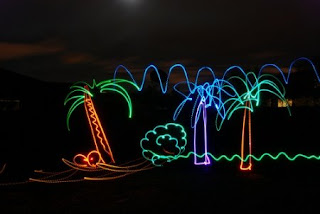
One hot new trend in photography is a technique called "light drawing" or "light graffiti." You've probably seen it in photos, videos, print ads, and even TV commercials. The process basically involves using long exposures in a dark area with a digital camera and LED or other light sources.
Unlike typical graffiti, this technique isn't illegal and doesn't cause property damage. It's essentially another form of time-lapse photography.
Before you start, make sure you have a digital camera that had manual settings. Some smaller/cheaper point-and-shoot cameras don't have this option. You'll need to change the shutter speed so that it stays open longer. And as stated previously, you'll need a light source (LED, flash light, glow stick, etc). A tripod also comes in handy because the camera needs to stay still while taking the shot.
Change the settings so the ISO is 100, the shutter is open to the widest aperture, disable the flash, and the exposure should be 10-30 seconds. You will also want to set a timer so you have time to get in front of the camera.
Hit the button on your camera to start taking the picture and get in front of the camera with your light source. If you set a delay, you might want to wait until the timer is up if you're drawing something specific (like letter, for example). When you're ready, start waving the light source around to "draw" your graffiti.
As you move around, your body will end up being a blur or ghost like figure in the actual photo (if at all). The light source will create streaks of light. You can draw shape, letters, and other designs. Just use your imagination and experiment with it.
One technique you can try is having another person stand perfectly still in the photo while you draw around them. You can point the light source at your face or other objects to create interesting reflections in the photo.
It's a lot of fun creating light graffiti in public because nobody will complain about your "drawings." They only exist in the photograph. You might even get some strange looks from people who have no idea why you're waiving a light at a camera!
For best results, use a good digital camera. Check out these digital camera reviews, and in particular, the Canon camera reviews.



